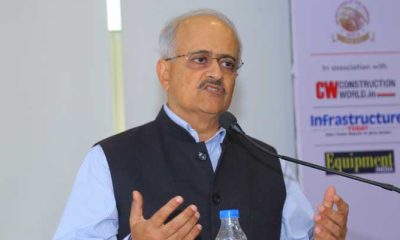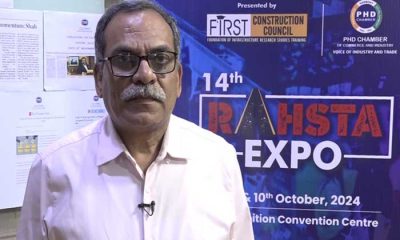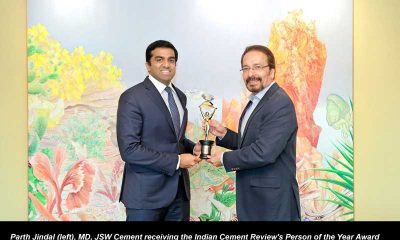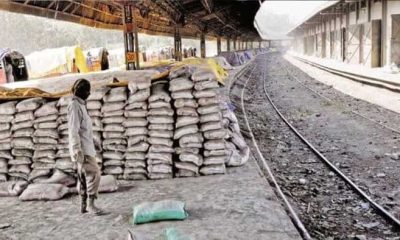Concrete
Material Benefits
Published
1 year agoon
By
admin
Environmental concerns and depleting natural resources, and the impact of cement production on the two are imminent issues that cement companies need to address on priority. Supplementary cementitious materials procured from industrial wastes is one way of looking at this colossal problem. ICR examines the changes made in company protocol with regards to sourcing of alternative materials and their overall impact.
Before we dive into the subject of supplementary cementitious materials, let us look at some of the key facts about cement production. India is the second largest producer of cement in the world. Limestone is at the core of its production as it is the prime raw material used for production. The process of making cement involves extraction of this limestone from its quarries, crushing and processing it at the cement plant under extreme temperatures for calcination to form what is called a clinker (a mixture of raw materials like limestone, silica, iron ore, fly ash etc.). This clinker is then cooled down and is ground to a fine powder and mixed with gypsum or other additives to make the final product – cement. The reason we are elucidating the cement production process is to look at how supplementary cementitious materials or SCM can be incorporated into it to make the process not only more cost effective but also environmentally responsible.
Limestone is a sedimentary rock composed typically of calcium carbonate (calcite) or the double carbonate of calcium and magnesium (dolomite). It is commonly composed of tiny fossils, shell fragments and other fossilised debris. This sediment is usually available in grey colour, but it may also be white, yellow or brown. It is a soft rock and is easily scratched. It will effervesce readily in any common acid. This naturally occurring deposit is depleting from the environment due to its extensive use in cement manufacturing process. Its extraction is the cause of dust pollution as well as some erosion in the nearby areas.
The process of calcination while manufacturing cement is a major contributor to carbon emission in the environment. This gives rise to the need of using alternative raw materials to the cement making process. The industry is advancing in its production swiftly to meet the needs of development happening across the nation.
According to the India Brand Equity Foundation (IBEF), the cement demand in India is estimated to touch 419.92 MT by FY 2027. As India has a high quantity and quality of limestone deposits through-out the country, the cement industry promises huge potential for growth. India has a total of 210 large cement plants out of which 77 are in the states of Andhra Pradesh, Rajasthan, and Tamil Nadu. Nearly 33 per cent of India’s cement production capacity is based in South India, 22 per cent in North India, 13 per cent in Central and West India, and the remaining 19 per cent is based in East India. As per Crisil Ratings, the Indian cement industry is likely to add approximately 80 million tonnes (MT) capacity by FY24, the highest since the last 10 years, driven by increasing spending on housing and infrastructure activities.
The Indian cement production overall stood at 263.12 million tonnes in 2021, and it is expected to reach 404.11 million tonnes by 2029 with a CAGR of 5.51 per cent during the forecast period, suggests a report published by Maximize Market Research in September 2022.
The production capacity and demand of cement in the country is increasing and is expected to grow at a steady rate in the years to come. The country is moving towards urbanisation and is building projects for the development of the nation. However, it is also imperative that the industry holds accountability of the environment and emission from this production activity and creates sustainable solutions to meet the demands as well as safeguard the planet as well.
India has pledged to achieve Net Zero by 2070 at the Glasgow Climate summits.
Environmental concerns and depleting natural resources are edging the cement industry to look at alternative materials for their manufacturing process.
Composition and Impact of SCM
Cement manufacturers know that to reduce CO2 emissions in the process of cement making, it is essential to change its composition. The raw mix of approximately 90 per cent limestone should be substituted with other materials with similar properties.
These materials, known as supplementary cementitious materials contribute to the properties of hardened concrete through hydraulic or pozzolanic activity. Typical examples are fly ashes, slag cement (ground, granulated blast-furnace slag), silica fumes etc. These can be used individually with portland or blended cement or in different combinations. SCM are often added to concrete to make concrete mixtures more economical, reduce permeability, increase strength, or influence other concrete properties. SCM may be added during cement manufacturing for a more consistent blended cement.
Some of the commonly used supplementary cementitious materials are:
Fly Ash: This material contains a substantial amount of silicone dioxide and calcium oxide. It is a fine, light, glassy residue, most widely used SCM in concrete and is a byproduct of coal combustion in electric power generating plants. Fly ash can compensate for fine materials that may be lacking in sand quantities and can be very beneficial
in improving the flowability and finishability of concrete mixtures.
Ground Granulated Blast-furnace Slag (GGBS): It is a by-product of the iron and steel industry. In the blast furnace, slag floats to the top of the iron and is removed. GGBS is produced through quenching the molten slag in water and then grinding it into a fine powder. Chemically it is like, but less reactive than, Portland cement.
Silica Fume: It is a by-product from the manufacture of silicon. It is an extremely fine powder (as fine as smoke) and therefore it is used in concrete production in either a densified or slurry form.
Slag: It is a by-product of the production of iron and steel in blast furnaces. The benefits of the partial substitution of slag for cement are improved durability, reduction of life-cycle costs, lower maintenance costs, and greater concrete sustainability. The molten slag is cooled in water and then ground into a fine powder.
Limestone Fines: These can be added in a proportion of 6 to 10 per cent as a constituent to produce cement. The advantages of using these fines are reduced energy consumption and reduced CO2 emissions.
Gypsum: A useful binding material, commonly known as the Plaster of Paris (POP), it requires a temperature of about 150oC to convert itself into a binding material. Retarded plaster of Paris can be used on its own or mixed with up to three parts of clean, sharp sand. Hydrated lime can be added to increase its strength and water resistance.
Cement Kiln Dust: Kilns are the location where clinkerisation takes place. It leaves behind dust that contains raw feed, partially calcined feed and clinker dust, free lime, alkali sulphate salts, and other volatile compounds. After the alkalis are removed, the cement kiln dust can be blended with clinker to produce acceptable cement.
Pozzolanas: These materials are not necessarily cementitious. However, they can combine chemically with lime in the presence of water to form a strong cementing material. They can include – volcanic ash, power station fly ash, burnt clays, ash from burnt plant materials or siliceous earth materials.
SCM used in conjunction with Portland cement contribute beneficially to the properties of concrete through hydraulic or pozzolanic activity or both. Hydraulic materials (e.g., slag cement), like Portland cement itself, will set and harden when mixed with water. Pozzolanic materials require a source of calcium hydroxide (CH) to set, which is supplied by Portland cement during the hydration process. The right dosage of strategically chosen SCM can improve both the fresh and hardened properties of a concrete mixture.
Prakhar Shrivastava, Head – Corporate Quality, JK Cement Limited, says, “We manufacture Portland Pozzolana Cement (PPC) from all our plants with addition of flyash up to 35 per cent and PPC in premium category with 20 per cent flyash to promote usage of only blended cement to fulfil customer requirements by achieving equivalent strength properties of Ordinary Portland Cement (OPC). At our south India plant in Muddapur, we also manufacture Portland Slag Cement (PSC) with the addition of slag at approximately 65 per cent, meeting all the internal product quality norms.”
“The production of Ordinary Portland Cement (OPC) is continuously declining, with a simultaneous increase in the production of blended cement like PPC, PSC, and Composite Cement based on flyash and granulated blast furnace slag. SCMs are increasingly used to minimise cement-related CO2 emissions and increase plant efficiency from an economic and environmental perspective,” he adds.
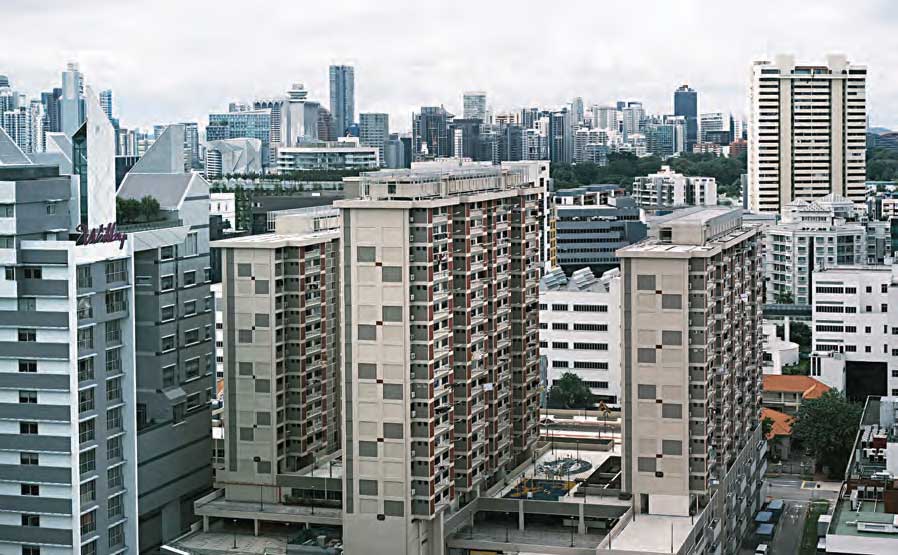


Achieving Sustainability through Substitution
Cement is the most used man-made material globally. The rising demand for infrastructure and development of the nation is showing a clear indication of increased production of cement, thus raising concerns about natural resources, environment, and emission of carbon. One of the widely adopted solutions for ensuring sustainability in cement manufacturing is reducing the clinker-to-cement ratio by adding supplementary cementitious materials.
In his authored article, Dr S B Hegde, Visiting Professor, Pennsylvania State University, United States of America, states, “Concrete is one of the most widely used materials after water worldwide by volume. Portland cement production is highly energy intensive, and emits significant amounts of CO2 through the calcination process, which contributes substantial adverse impact on global warming. Efforts are needed to produce more ecologically friendly concrete with improved performance and durability.”

“The conventional SCM are not enough considering the quantity of concrete requirement for infra development worldwide and to mitigate global warming issue; there is a pressing need to explore the new SCM, its characterisation, performance evaluation, standardisation and adoption,” he adds.
The CO2 emissions from cement production are the third largest source of difficult-to-eliminate emissions, after load-following electricity and iron and steel. Beyond greenhouse gas (GHG) emissions, the production of concrete and mortar causes over approximately three per cent of global energy demand, over five per cent of global anthropogenic particulate matter (PM10) emissions, and approximately two per cent of global water withdrawals. These environmental impacts may be reduced through various technical (energy, emissions, and material efficiency) measures, of which cementitious materials (CM) substitution (including complete and partial substitution) is one of the most promising.
The manufacturing process of cement can become sustainable by measuring the impact of supplementary materials that can be added to the raw meal of cement. Various materials, naturally occurring or man-made or wastes should be studied and consequently should be included in the cement production process to create blended cements that not only meet the rising demands of the world in terms of quality and strength, but at the same time meet environmental concerns. Research, innovation and technology is key to making a difference in the segment of cement manufacturing by studying more materials that can be used as supplementary materials in cement and concrete, by crafting new compositions and blends of cement and crafting equipment that support the same.
One of the most important ways of reducing carbon emission in cement manufacturing is the use of alternative raw materials from various other industries. This gives way to a circular economy, utilising waste from other industries and bettering the environment with reduced emission of harmful gases, especially carbon dioxide. It also helps the avoidance of landfills or ocean pollution, as waste of industries is utilised in manufacturing cement. Overall, new compositions of cement are the future. The nation’s economy can greatly benefit from a growing cement industry and business sector, however, it should pay keen attention on finding pathways to safeguard the environment its people reside in.
-Kanika Mathur

The transportation and logistics landscape in the Indian cement industry is witnessing significant evolution, driven by technological advancements and sustainability considerations. From the integration of electric vehicles to the adoption of advanced technologies like IoT and AI, cement companies are embracing innovation. ICR explores the transformative trends shaping the future of transportation and logistics.
The second-largest road transportation network in the world is in India. From one place to another, a transportation system moves both people and things. Machines rule the transportation industry nowadays, while transportation routes or channels serve as the key arteries of our economy.
The logistics industry is crucial to both enterprises and the economy. In today’s interconnected world, shipping and logistics are at the heart of the economy, acting as vital gateways for international trade and business. More than 95 per cent of the nation’s traffic is transported by roads and railways, which are the main modes of transportation. The railways and roads would continue to rule the transportation scene in the near future, even though other modes including coastal shipping and inland water transport would play a larger role.
According to Statista Market Insights 2024, the value added in the transportation market is projected to amount to Rs.7.88tn in 2024, the transportation intensity in India is projected to amount to 1.1200TKM/GDP and the volume of goods transported in the transportation market is projected to amount to 4,583.00bn TKM in 2024.
Pushpank Kaushik, CEO, Jassper Shipping, says, “The shipping and logistics industry is an essential component of the global supply chain and the rise of e-commerce, globalisation, and ever-increasing customer demands for faster delivery times have pushed the boundaries of traditional shipping methods. As a result, the sector is undergoing a significant revolution owing to the use of automation and technology. Automation is a key factor that facilitates the accuracy and efficiency of processes involved in shipping and logistics. Technology has also improved the safety and security of shipping and logistics operations with minimised communication gaps through mobile applications, cloud servers, etc. Real-time tracking and management of inventory through automation help in the identification of errors and delays in the delivery process. It enables logistics companies to have access to their operations and look for drawbacks that may demand improvements, leading to cost reduction.”
TECHNOLOGY OF TRANSPORT
The role of technology in transportation and logistics within the cement industry is paramount, revolutionising traditional practices and ushering in unprecedented efficiency and cost-effectiveness. Technology plays a crucial role in optimising various aspects of the transportation process, from route planning to fleet management. Utilising advanced algorithms, companies can analyse factors such as traffic patterns, road conditions, and delivery schedules to optimise routes, minimising transit time and
fuel consumption.
“The integration of new technology and digitalisation has significantly enhanced both the efficiency and cost-effectiveness of our plant operations. By leveraging advanced analytics, real-time monitoring and automation solutions, we have been able to optimise resource utilisation, minimise downtime and reduce overhead costs. Additionally, digitalisation has improved decision-making processes, enabling us to respond swiftly to changing market dynamics and customer demands,” says Vinod Agarwal, Logistics Head, Wonder Cement.
Moreover, the integration of cutting-edge technologies such as Internet of Things (IoT), GPS, and telematics has enabled real-time tracking and monitoring of vehicles and shipments. IoT sensors installed in trucks and cargo containers provide valuable data on location, temperature, humidity, and other relevant parameters. This real-time visibility enhances transparency and accountability throughout the transportation chain, allowing for proactive decision-making and timely interventions to address any issues that may arise.
Dhriti Prasanna Mahanta, Vice President & Business Head, TeamLease Degree Apprenticeship says, “The global integration of AI into the logistics, transportation, and supply chain sectors is experiencing remarkable growth, with projections soaring from $412 million to an astounding $13,948 million by 2032, reflecting an impressive CAGR of 43.5 per cent. However, amidst this global surge, India emerges as a promising market poised for significant expansion. Reports suggest that the logistics industry in India is poised and expected to create 10 million jobs by 2027. Furthermore, the Indian freight and logistics market is projected to grow at an annual rate of 8.8 per cent, reaching $484.43 billion by 2029,
up from $317.26 billion in 2024. This underscores the critical need for skilled professionals
proficient in AI technologies to meet the industry’s evolving demands.”
Furthermore, GPS and telematics systems facilitate effective fleet management by enabling remote monitoring of vehicle performance, fuel consumption and driver behaviour. This data-driven approach allows companies to identify inefficiencies, optimise routes and reduce operational costs. Additionally, predictive maintenance algorithms help minimise downtime by alerting maintenance teams to potential issues before they escalate into costly breakdowns.
Prashant Jha, Chief Ready-Mix Concrete and Modern Building Materials Officer, Nuvoco Vista, says, “Our implementation of a Vehicle Tracking System (VTS) in our transit mixers, coupled with Drum Rotation Sensors and GPS integration, has revolutionised our operational efficiency. This advanced technology empowers our plant to monitor transit mixers in real-time, facilitating agile planning for subsequent deliveries and enabling us to provide customers with precise updates on delivery status. Moreover, by leveraging GPS data, we ensure fair variable cost payments based on accurate kilometres travelled, optimising cost management. In addition to enhancing financial transparency, the VTS enables our plant teams to track driver behaviour, allowing us to provide timely feedback and targeted training on safe work practices. This hands-on approach not only improves the safety of concrete transportation but also fosters a culture of continuous improvement within our workforce.”
Automation technologies, ranging from autonomous vehicles to robotic warehouses, are revolutionising traditional logistics operations. In the context of transportation, autonomous vehicles, including trucks and drones, are being increasingly deployed to transport raw materials and finished products. These vehicles leverage advanced sensors, artificial intelligence, and machine learning algorithms to navigate roads safely and efficiently, reducing the need for human intervention and minimising the risk of accidents.
“A major challenge in the cement industry is the logistics cost and time for delivery. This can only be resolved with faster turnaround time, complete visibility of shipments, delivery lead time and process control to adhere to compliance,” explains Haresh Calcuttawala, CEO and Co-Founder, Trezix.
Furthermore, automation plays a significant role in warehouse operations, where robotic systems are employed for tasks, such as loading and unloading cargo, sorting materials, and managing inventory. These automated solutions not only improve operational efficiency but also optimise space utilisation and enhance inventory accuracy, ultimately leading to cost savings and improved customer satisfaction.
Additionally, automation enables the integration of predictive analytics and real-time data processing, allowing logistics companies to anticipate demand, optimise routes, and mitigate disruptions proactively. By harnessing the power of data-driven insights, companies can make informed decisions and adapt quickly to changing market dynamics, thereby gaining a competitive edge in the industry.
Guru Prasad, Assistant Vice President, CSSR and Electronics, Robotics and Discrete, ABB India, elaborates, “ABB Robotics can help cement plants find a balance between volume, speed, accuracy and flexibility through their automation solutions for logistics applications. Automating cement plants can provide various benefits such as supporting the workforce. If the cement plant is to achieve the speed, efficiency and resilience required by today’s complex world, companies must integrate automation, digital connectivity and edge technologies such as artificial intelligence and robotics. The successful integration of these technologies is critical to keep the plant operational in both normal and emergency situations. There are likely to be more operations that run entirely autonomously. Robotic automation is increasingly being used to tackle monotonous, hazardous and challenging tasks that can increase productivity, boost operational efficiency and generate a higher return on investment for businesses. This makes the plant safer for human workers and allows them to focus on more skilled and fulfilling tasks.”
ELECTRIC VEHICLES
According to the report Electric Vehicles: Revving Up Despite Roadblocks by CareEdge Ratings, January 2024, the sales volume of electric vehicles in CY23 surpassed 1.5 million, a 50 per cent increase compared to CY22. Total EV volume sold was recorded at 1.53 million in CY23 compared to 1.02 in CY22. Growth was driven by the increasing adoption of EVs and several exciting new EV models across segments giving better options. CY24 looks promising with the industry expecting to surpass sales volume of 2 million in CY24, underpinned by surging demand and sustained government support through incentives. However, investments in the
EV ecosystem remain crucial for fostering EVs’ massive adoption.
The growth momentum is expected to continue in CY24, driven by the government’s increased focus on electrification at both the Central and state levels, the potential extension of FAME II, the improving EV ecosystem with a significant increase in charging stations, the envisaged reduction in battery costs leading to the lower total cost of ownership (TCO) compared to ICE, and the development of new models across categories, thus continuing to drive demand for EVs. An increase in the number of EVs will promote sustainability and reduce carbon emissions, contributing to the government’s environmental goals. The massive adoption of EVs can boost battery technology and infrastructure, further enhancing the EV ecosystem. These incentives reduce the upfront cost of vehicles, making them more attractive to consumers.
In cement transportation, electric vehicles (EVs) present a promising avenue for achieving sustainability goals while addressing the industry’s unique challenges. However, along with immense opportunities, several hurdles must be overcome to realise the full potential of EV adoption. One of the primary challenges is the need to address infrastructure limitations. This includes the establishment of a robust charging infrastructure network capable of supporting the widespread deployment of EVs for cement transportation. Investing in charging stations along transportation routes and at key logistical hubs will be essential to ensure uninterrupted operations and facilitate the transition to electric fleets.
Raman Bhatia, Founder and Managing Director, Servotech Power Systems, asserts, “Shifting industrial transportation fleets to EVs can lead to reduced greenhouse gas emissions. Transportation is a major contributor to greenhouse gas emissions, particularly CO2. An EV produces zero tailpipe emissions, significantly reducing emissions and mitigating climate change. Petrol and diesel trucks emit harmful pollutants like nitrogen oxides and particulate matter. Replacing these vehicles with EVs can significantly improve air quality, especially in urban areas with high traffic congestion. Lastly, widespread EV adoption can lessen dependence on fossil fuels, particularly imported oil. This can enhance energy security and reduce geopolitical vulnerability.”
Moreover, the upfront cost of EVs and associated infrastructure investments may pose financial challenges for cement companies, especially smaller players. However, opportunities exist for innovation and investment in EV technology tailored to meet the specific needs of the cement industry. This includes the development of specialised EV models designed for heavy-duty applications, such as transporting bulk materials like cement and aggregates over
long distances.
Furthermore, advancements in battery technology and energy storage solutions offer promising opportunities to overcome range limitations and improve the overall efficiency of electric transportation in the cement industry. Research and development efforts focused on enhancing battery performance, reducing charging times, and increasing energy density will be crucial in driving the widespread adoption of EVs.
TRANSPORTATION AND SUSTAINABILITY
Sustainability has become a core focus for the cement industry, extending beyond production processes to encompass transportation and logistics operations. Recognising the environmental impact associated with transportation, cement companies are implementing various sustainability initiatives and practices to reduce carbon emissions, minimise resource consumption and enhance overall environmental stewardship.
“Making sustainable practices a priority in the shipping and logistics sector is crucial to ensure a significant impact on the environment and the industry. Companies can turn cost effective and save money by investing in green technologies such as hybrid or electric ships, alternative fuels, and automated route optimisation systems. By investing in sustainable practices, companies can ensure compliance with government regulations, avoiding fines and other consequences that could affect their bottom line. With growing consumer awareness of environmentally friendly practices, companies adopting sustainable policies can differentiate themselves from their competitors and attract more customers, ultimately boosting the revenue charts,” says Kaushik.
One key sustainability initiative in transportation and logistics is the adoption of alternative fuels and energy-efficient vehicles. Cement companies are increasingly incorporating biofuels, natural gas, and electric vehicles into their fleets to reduce reliance on fossil fuels and lower greenhouse gas emissions. By investing in energy-efficient vehicles and alternative fuels, companies can significantly decrease their carbon footprint while also reducing fuel costs over the long term.
Cement manufacturers today are prioritising route optimisation and logistics planning to minimise transportation distances and reduce fuel consumption. Advanced data analytics and logistics software are being utilised to optimise delivery routes, consolidate shipments, and maximise vehicle capacity utilisation. These efforts not only reduce emissions but also enhance operational efficiency and reduce transportation costs.
Shrivats Singhania, Director and CEO of Udaipur Cement Works (UWCL), states, “As cement production grows, so does the demand for efficient logistics and transportation. At UCWL, we recognise this link. Increased production volume necessitates a robust and adaptable logistics network to ensure timely and efficient product delivery. We are continuously evaluating and optimising our logistics network to meet this growing demand. Beyond simply scaling our operations, we are committed to sustainable practices across the supply chain. We have implemented innovative strategies like CNG-powered truck distribution to reduce our carbon footprint during transportation. These initiatives not only optimise logistics and distribution but also demonstrate UCWL’s unwavering commitment to environmental responsibility. We believe that sustainable practices and efficient operations go hand-in-hand, and we are actively working to achieve both.”
In addition to improving vehicle efficiency and logistics optimisation, cement companies are implementing sustainable packaging solutions to minimise waste and reduce environmental impact. Innovative packaging materials, such as recyclable and biodegradable materials, are being explored to replace traditional packaging materials like plastic and cardboard. Furthermore, companies are investing in returnable packaging systems to minimize waste and promote circularity within the supply chain.
FUTURE AND INNOVATION OF TRANSPORTATION
Ankit Kumar, Co-Founder and CEO, Skye Air, affirms, “In the foreseeable future, the incorporation of drone deliveries holds promise for integration within the cement industry, presenting efficient and swift transportation solutions for materials. The sophisticated drone technology prevalent in logistics stands poised to collaborate seamlessly with cement companies, optimising their supply chain operations. Drones offer the potential to ferry small batches of cement or other construction materials to remote or challenging-to-access locations, thereby diminishing reliance on conventional transportation modes such as trucks and mitigating logistical complexities. Through the strategic utilisation of drones, the cement industry stands to bolster its efficiency, curtail costs and elevate overall operational efficacy.”
The future of transportation and logistics in the Indian cement industry is set to undergo significant transformation, driven by technological advancements and sustainability imperatives. Expectations include a rapid uptake of electric vehicles to cut carbon emissions and meet stringent environmental regulations. Further, advanced technologies like IoT and AI will revolutionise operations, optimising route planning and enhancing supply chain visibility. Sustainable packaging solutions are anticipated to gain traction, while collaboration across the supply chain will drive innovation and efficiency. Emphasis on optimisation and cost reduction will remain paramount, with data analytics and automation playing pivotal roles. Overall, the industry’s future outlook promises a greener, more efficient and collaborative approach to cement transportation and logistics.
- –Kanika Mathur
Concrete
Filtration can help to control climate change
Published
17 hours agoon
April 16, 2024By
admin
Niranjan Kirloskar, Managing Director, Fleetguard Filters, elaborates on the importance of filtration and its profound impact on efficiency, longevity and environmental sustainability.
Tell us about the core principle of filtration.
Filtration is segregation/separation of matter by density, colour, particle size, material property etc. Filtration is of four basic types:
- Separation of solids from gas
- Separation of solids from liquids
- Separation of liquids from liquids
- Separation of Solids from solids.
As applied to engines/equipment, the main objective of filtration is to purify the impurities and provide the desired fluid or air for enhanced engine/equipment performance in turn optimising their performance and life.
Can better filtration bring productivity to the work process? How?
Better filtration can improve the quality of application performance in multiple ways. Filtration improves engine performance as it filters and prevents dirt, dust, and debris from entering into the engine. This ensures that the quality of air or fluid that reaches the combustion chamber is as per the specific requirements of optimal performance of the engine. It also extends engine life by filtering out contaminants. Efficient filtration ensures optimal performance of the engine/equipment over its entire operating life. Filtration also improves fuel efficiency as a clean filter allows for a better air-fuel mixture in the engine, thus improving combustion efficiency, which in turn results in better fuel economy. It keeps emissions under control as fuels burn more efficiently leading to lesser harmful residue in the environment. Thus, to sum up, an optimal filtration solution ensures better performance, prolonged engine life and less hazardous waste in the environment.
What is the role of technology in the process of filtration?
Innovation, research and development as well as technology play a pivotal role in catering to the ever-evolving environmental norms and growing market demands. At FFPL we have NABL Accredited labs for testing, we have ALD Labs for design, and a team of R&D experts constantly working on providing advanced solutions to cater to the evolving market needs. We have robust systems and advanced technologies that make high-quality, high-precision products. Our state-of-the-art manufacturing facilities use advanced technologies, automation, robotics and also Industry 4.0 as applicable to provide the best products to our customers. To ensure each product delivered to market is of utmost precision, advanced quality equipment such as CMM, scanning systems and automated inspection technologies for real-time monitoring and quality control during the manufacturing of filtration systems and to comply with standard quality requirements are used.
Tell us about the impact of good filtration on health and the environment.
Good filtration of equipment is to the environment what a good respiratory system is to the body. There are various benefits of an efficient air filtration system as it improves the air quality by ensuring optimum combustion of fuel thereby reducing/controlling emissions to the environment. Efficient lube filtration ensures low wear and tear of the engine thereby extending life of the engines and maintaining optimal performance over the entire operating life of the engine. Efficient fuel filtration ensures low wear and tear of expensive and sensitive fuel injection thereby ensuring perfect fuel metering resulting in best fuel efficiency and saving of precious natural resources. This efficient filtration can help to control climate change as it reduces the carbon footprint due to combustion in the environment.
Can your products be customised and integrated with other machinery?
Fleetguard Filters have been known as a leading solutions provider for decades. With relevant experience and close customer relations, we understand the market/applications requirements and develop solutions to address the pressing technical challenges our customers face concerning filtration solutions. Filters can be customised in terms of size, shape and configuration to fit specific requirements. Customised filters can be designed to meet critical performance requirements. Filtration systems can be designed to integrate seamlessly with any auto and non-auto application requirements.
What are the major challenges in filtration solutions?
Major challenges faced in filtration solutions are:
- With every emission regulation change, filtration requirements also keep changing.
- Engines are being upgraded for higher power ratings.
- Space for mounting filtration solutions on vehicles/equipment is shrinking.
- For fuel injection systems, the water separation efficiencies are becoming more and more stringent, so are particle separation efficiencies.
- Due to next level filtration technologies,filtration systems and filter elements are becoming expensive, thereby increasing TCO for customers.
- Customers prefer higher uptimes and longer service intervals to ensure lower maintenance and operating costs.
We, at Fleetguard, strive continuously to ensure that all the pains experienced by our customers are addressed with the fit to market solutions. Balancing the cost of filtration solutions with their performance and durability can be challenging, especially where the requirements of high filtration standards are required. Also, wrong disposal methods for used filters can have environmental impact.
- –Kanika Mathur
Concrete
We are committed to sustainable practices
Published
19 hours agoon
April 16, 2024By
admin
Shrivats Singhania, Director and CEO of Udaipur Cement Works (UWCL), shares how the company has embraced cutting-edge technologies and sustainable practices to strengthen its logistics and minimise its carbon footprint.
What is your current production capacity and what are your plans for expansion?
Udaipur Cement Works Limited (UCWL) recently achieved a significant milestone with the inauguration of the newly installed cement grinding and packaging section at our Dabok Plant in Udaipur, Rajasthan. This state-of-the-art facility has nearly doubled our production capacity, from 2.2 million metric tonnes (MT) per annum to an impressive 4.7 million MT per annum.
This expansion wasn’t just about volume – it was a strategic move aligned with catering to the growing demand for high-quality cement in the region. It also allows us to enhance our efficiency and overall competitiveness in the market.
UCWL is committed to continuous improvement and growth within the cement industry. We are constantly looking for ways to expand our operations and better serve our customers.
With the growing production of cement industry wide, how is the cement industry managing its carbon footprint?
The growing production in the cement industry necessitates addressing our collective carbon footprint. At UCWL, we recognise this responsibility and are actively implementing several strategies to minimise our environmental impact. One key approach is embracing advanced technologies. Our recent expansion with the newly installed cement grinding and packaging section incorporates cutting-edge features that enhance efficiency and reduce energy consumption.
Additionally, we have commissioned a Waste Heat Recovery System (WHRS) that utilises waste heat of the pyro-process for power generation. This along with our Captive Solar Power Plants significantly increases our Green Energy share, exceeding 50 per cent of our total electrical consumption.
Furthermore, we recently doubled our Clinker Capacity. While clinker production can be energy-intensive, this expansion allows us to explore alternative fuels and optimise the overall production process, reducing our environmental impact per unit of cement produced.
These initiatives exemplify UCWL’s dedication to environmental stewardship. We are committed to continuous improvement and believe that innovation, coupled with responsible practices, can lead to a more sustainable future for the cement industry.
Tell us about the role of digitalisation and automation in the cement production process.
Digitalisation and automation play a pivotal role in revolutionising the cement production process by enhancing efficiency, productivity and product quality. UCWL has embraced cutting-edge technologies to optimise operations, improve product quality, reduce energy consumption, and ensure timely maintenance. By leveraging automation and digitalisation, UCWL is at the forefront of innovation in the industry, driving operational excellence and setting new benchmarks for efficiency and sustainability.
As the production of cement grows, how does it impact other processes such as logistics, transportation and distribution?
As cement production grows, so does the demand for efficient logistics and transportation. At UCWL, we recognise this link. Increased production volume necessitates a robust and adaptable logistics network to ensure timely and efficient product delivery. We are continuously evaluating and optimising our logistics network to meet this growing demand.
Beyond simply scaling our operations, we are committed to sustainable practices across the supply chain. We have implemented innovative strategies like CNG-powered truck distribution to reduce our carbon footprint during transportation.
These initiatives not only optimise logistics and distribution but also demonstrate UCWL’s unwavering commitment to environmental responsibility. We believe that sustainable practices and efficient operations go hand-in-hand, and we are actively working to achieve both.
What are the sustainability initiatives undertaken by your organisation?
UCWL prioritises sustainability as a core principle. We have actively embarked on a comprehensive journey to minimise our environmental impact and promote responsible practices across our entire operation. This commitment is evident in several key initiatives.
A pioneering first for the Indian cement industry, UCWL deployed a floating solar power plant, significantly reducing our reliance on fossil fuels and contributing to cleaner energy generation. We are also constantly exploring innovative methods for transporting loose cement, with the goal of minimising environmental impact and dust generation during transportation.
These initiatives, along with many others, exemplify UCWL’s unwavering commitment to sustainability. We strive for energy efficiency throughout our operations and are dedicated to environmental stewardship within the cement industry. We believe these efforts will pave the way for a more sustainable future for our company and the environment.
Tell us about the major challenges that may arise in the cement plant and how they are managed.
The cement industry operates in a dynamic landscape, and UCWL recognises that our plants can face several challenges. These can range from managing energy consumption to minimising environmental impact and maintaining peak operational efficiency.
At UCWL, we take a proactive approach to address these challenges. Energy consumption is a significant concern across the industry. We combat this by embracing cutting-edge technologies like automation and digitalisation. These advancements optimise processes, minimise energy waste, and maximise output, leading to greater efficiency in our production.
Minimising our environmental footprint is another top priority. We are committed to implementing sustainable practices throughout our operations. A prime example is our pioneering deployment of a floating solar power plant, the first of its kind in the Indian cement industry. This significantly reduces our reliance on fossil fuels and contributes to cleaner energy generation. Additionally, we utilise WHRS, which not only reduces our environmental impact but also contributes to energy efficiency.
Finally, maintaining peak operational efficiency is crucial for our success. We believe in continuous improvement and are constantly seeking new solutions to further optimise our operations. By proactively addressing these challenges through a combination of innovative solutions, sustainable practices and a commitment to continuous improvement, UCWL effectively manages its plants. This allows us to deliver high-quality cement while minimising our environmental impact.
Tell us about the future outlook of the organisation
The future outlook of UCWL is characterised by a strong emphasis on sustainability, innovation, and growth. By continuing to invest in green energy, automation, and digitalisation, UCWL is poised to maintain its position as a key player in the cement industry.
The company’s strategic vision focuses on meeting market demands, driving operational efficiency and upholding its commitment to sustainability and quality. With a forward-looking approach, UCWL is well-positioned to navigate industry challenges and capitalise on opportunities for continued success and leadership in the cement sector.
- –Kanika Mathur

The Freight Factor

Filtration can help to control climate change

We are shaping the future of clean air

We are committed to sustainable practices

A proactive approach facilitates smooth operations

Environment Ministry revises rules of solid waste management

M-sand boards new terrain

Process and quality optimization in cement plant.
Concrete: A Highly Sustainable Building Material







